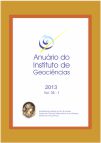Hydrodynamic Aspects, Water Budget and Flow Simulation in the Coastal Aquifer of Itaipuaçu, Marica - Rio de Janeiro, Brazil
DOI:
https://doi.org/10.11137/2013_2_105_116Abstract
This research was conducted in the coastal aquifer of Itaipuaçu district, Marica, Rio de Janeiro in Brazil. This is an aquifer of great importance for the region, as it is still the only autochthonous means of water supply for a growing population. The use of this water resource without control is a big problem, because quality can be impaired by contamination coming from the surface and, as a coastal aquifer, overexploitation can generate migration of saltwater / freshwater interface towards mainland and can salinize it. The paper aims to present the hydrodynamic characteristics of the shallow aquifer of the study area, by assessing local flow, flow parameters of the aquifer, acquisition and processing of meteorological data and water balance of the aquifer system, with the application of Visual Balan V.2.0 code. Other calculation methodologies were employed, as hydrometeorological simplified balance (Easybal v.4 computer code) and water balance with use of Darcy's Law. Wells were drilled in the shallow aquifer of the study area to assess local stratigraphy, and interference tests were performed to obtain physical parameters of the aquifer (permeability and storage coefficient). In situ measurements of water levels in wells were performed in the region to map the shallow aquifer head distribution. The data indicate a low hydraulic gradient and equipotential lines subparallel to the shoreline. Based on the hydraulic parameters, flow simulations were performed with the software Visual Modflow 4.2. The results obtained to date indicate a recharge of about 36% of the precipitation and hydraulic gradient less than 1%. Obtaining in situ parameters of the aquifer was crucial for the proper model fit and evaluation of the local aquifer properties.Downloads
Download data is not yet available.
Downloads
Published
2013-01-01
How to Cite
Eger, G. Z. da S., Silva Junior, G. C. and Cristo, V. do N. (2013) “Hydrodynamic Aspects, Water Budget and Flow Simulation in the Coastal Aquifer of Itaipuaçu, Marica - Rio de Janeiro, Brazil”, Anuário do Instituto de Geociências. Rio de Janeiro, BR, 36(2), pp. 105–116. doi: 10.11137/2013_2_105_116.
Issue
Section
não definida
License
This journal is licensed under a Creative Commons — Attribution 4.0 International — CC BY 4.0, which permits use, distribution and reproduction in any medium, provided the original work is properly cited.















